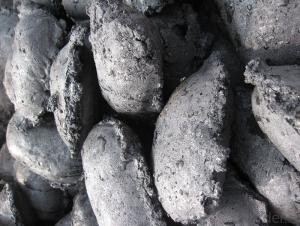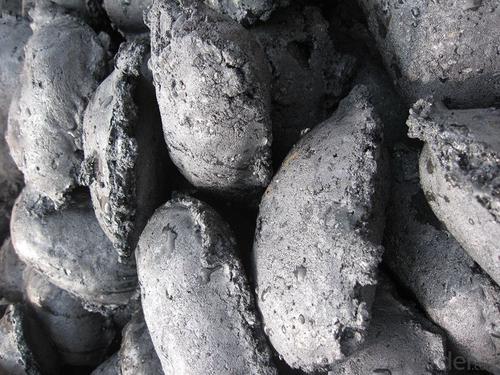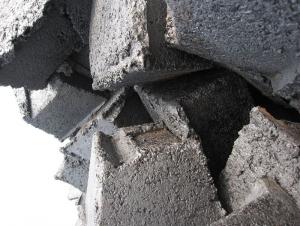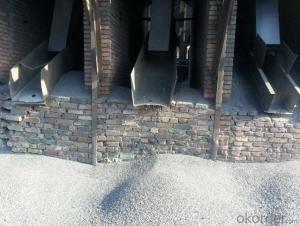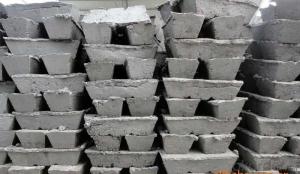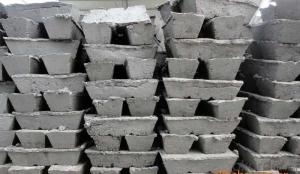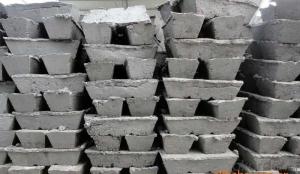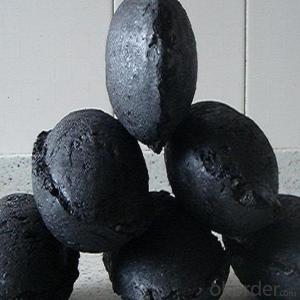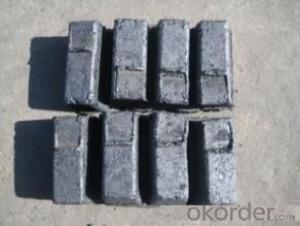Carbon Electrode Paste Block with Ash 4.0%
- Loading Port:
- Lianyungang
- Payment Terms:
- TT OR LC
- Min Order Qty:
- 20 m.t.
- Supply Capability:
- 1000 m.t./month
OKorder Service Pledge
OKorder Financial Service
You Might Also Like
Spcifications
Carbon Electrode Paste Block with Ash 4.0%
1:carbon eletrode paste
2:for ferroalloy,calcium carbide manufacture
3:HS 3801300000,YB/T5212-1996,ISO9001:2008
Product Description
Carbon Electrode Paste Block with Ash 4.0%
Carbon Electrode Paste is a self-baking electrode used in submerged arc furnaces for delivering power to the charge mix. Electrode Paste is added to the top of the electrode column in either cylindrical or briquette form. As the paste moves down the electrode column the temperature increase causes the paste to melt and subsequently bake forming a block of electrically conductive carbon. Electrode Paste is essentially a mix of Electrically Calcined Anthracite (ECA) or Calcined Petroleum Coke (CPC) with Coal Tar Pitch.
Product Feature
Carbon Electrode Paste Block with Ash 4.0%
Graphite/Carbon Electrode Paste
Specification/Item
Ash 4.0%max5.0%max 6.0%max7.0% Max9.0% Max11.0% Max
VM 12.0%-15.5%12.0%-15.5%12.0%-15.5%9.5.0%-13.5%11.5%-15.5%11.5%-15.5%
Strength
Compress 18.0Mpa Min17.0Mpa Min15.7Mpa Min19.6Mpa Min19.6Mpa Min19.6Mpa Min
Specific 65μΩm Max68μΩm Max75μΩm Max80μΩm Max90μΩm Max90μΩm Max
Resistance
Bulk Density1.38G/CM3 Min1.38G/CM3 Min1.38G/CM3 Min1.38G/CM3 Min1.38G/CM3 Min1.38G/CM3 Min
Product Picture
Carbon Electrode Paste Block with Ash 4.0%
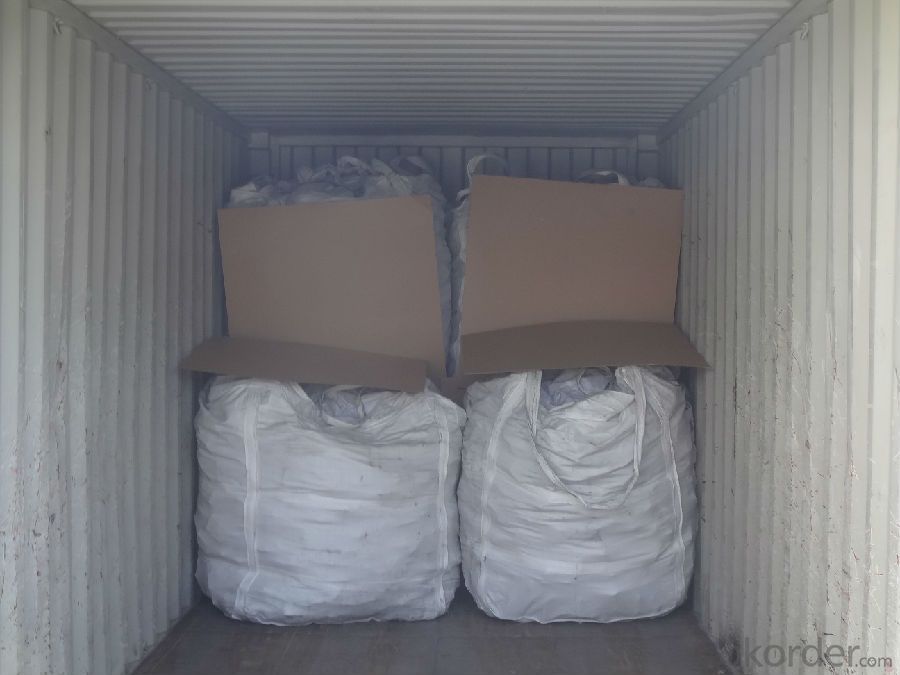
Carbon Electrode Paste Block with Ash 4.0%
Advantage:
1.High quality and competitive price.
2.Timely delivery.
3.If any item you like. Please contact us.
Your sincere inquiries are typically answered within 24 hours.
- Q: What are the effects of carbon emissions on the stability of volcanic regions?
- Carbon emissions can potentially have both positive and negative effects on the stability of volcanic regions. On one hand, increased carbon dioxide levels in the atmosphere can contribute to global warming, which in turn may lead to melting of glaciers and ice caps, resulting in a rise in sea level. This rise in sea level can increase the likelihood of volcanic flank collapse, as the added pressure weakens the stability of volcanic slopes. Additionally, global warming can also trigger more frequent and intense rainfall, potentially leading to increased erosion and landslides in volcanic areas. On the other hand, carbon dioxide emissions can also have a stabilizing effect on volcanic regions. The injection of carbon dioxide into volcanic systems can enhance the pressure within magma chambers, promoting magma crystallization and solidification. This process can reduce the likelihood of volcanic eruptions, as the solidified magma acts as a barrier that hinders the movement and release of magma. Overall, the effects of carbon emissions on the stability of volcanic regions are complex and dependent on various factors. It is crucial to continue studying these interactions to better understand the potential consequences and implications for volcanic hazards and the overall stability of volcanic regions.
- Q: Yes, I have a weapon, want to strengthen 11, said to be advanced furnace rock carbon, do not know how to get, look at the prawns pointing
- Is there still any carbon in the furnace?After the revision, there is no, where did not sell, the furnace rock carbon has turned into colorless small crystals
- Q: How are carbon nanomaterials used in electronics?
- Carbon nanomaterials, such as carbon nanotubes and graphene, are used in electronics due to their exceptional electrical and thermal properties. They can be used as conductive additives in electronic devices, enabling faster and more efficient electron transport. Carbon nanomaterials are also used as transistors, making it possible to build smaller and more powerful electronic components. Additionally, their high surface area and mechanical strength make them suitable for energy storage devices like batteries and supercapacitors. Overall, carbon nanomaterials play a crucial role in enhancing the performance and miniaturization of electronic devices.
- Q: What are the effects of carbon emissions on the stability of estuaries?
- Estuaries, which are highly productive and diverse ecosystems, are greatly impacted by carbon emissions. These emissions, primarily in the form of carbon dioxide (CO2), contribute to climate change and ocean acidification, resulting in detrimental effects on estuaries. Sea-level rise is one of the most significant consequences of carbon emissions on estuaries. As global temperatures increase, the melting of glaciers and ice caps causes sea levels to rise. Estuaries, being low-lying areas where rivers meet the sea, are particularly vulnerable to this rise. Consequently, higher water levels lead to increased flooding, erosion, and saltwater intrusion into freshwater systems within estuaries, negatively affecting their overall stability. Furthermore, the concentration of CO2 in the atmosphere leads to ocean acidification. When CO2 dissolves in seawater, it forms carbonic acid, which lowers the water's pH. This acidification has detrimental effects on marine life within estuaries, especially organisms with calcium carbonate shells like shellfish and oysters. The increased acidity makes it more challenging for these organisms to build and maintain their shells, resulting in reduced populations and biodiversity in estuaries. Climate change, caused by carbon emissions, also alters temperature and precipitation patterns in estuaries, disrupting the delicate balance of saltwater and freshwater. Estuaries rely on this balance to support their unique ecosystems. Changes in temperature and precipitation disturb this equilibrium, causing significant shifts in species composition and distribution. Some species may struggle to adapt, while invasive species may thrive, further destabilizing estuarine ecosystems. In conclusion, the effects of carbon emissions on estuaries are extensive and varied. Rising sea levels, ocean acidification, and climate-induced changes in salinity and freshwater availability all contribute to the degradation of estuaries and the loss of biodiversity. To protect and preserve these essential ecosystems for future generations, it is crucial to reduce carbon emissions and mitigate climate change.
- Q: How do fossil fuels release carbon dioxide when burned?
- When fossil fuels are burned, the carbon atoms present in them combine with oxygen from the air, resulting in the release of carbon dioxide (CO2). This process, known as combustion, produces energy and water vapor as byproducts.
- Q: What are the different types of carbon-based plastics?
- There are several different types of carbon-based plastics, each with unique properties and applications. Some common types include: 1. Polyethylene (PE): This is the most widely used plastic and can be found in various forms such as high-density polyethylene (HDPE) and low-density polyethylene (LDPE). PE is known for its strength, flexibility, and resistance to chemicals, making it suitable for applications like packaging, pipes, and toys. 2. Polypropylene (PP): PP is another popular plastic known for its high melting point, chemical resistance, and durability. It is commonly used in automotive parts, appliances, and packaging. 3. Polystyrene (PS): PS is a rigid plastic that is often used in disposable products like food containers and packaging materials. It is lightweight and has good insulation properties. 4. Polyvinyl Chloride (PVC): PVC is a versatile plastic that can be rigid or flexible depending on its formulation. It is commonly used in construction materials, pipes, cables, and vinyl flooring. 5. Polyethylene Terephthalate (PET): PET is a strong and lightweight plastic that is commonly used in beverage bottles, food packaging, and textile fibers. It is known for its excellent gas and moisture barrier properties. 6. Polycarbonate (PC): PC is a transparent plastic known for its high impact resistance and heat resistance. It is often used in eyewear, automotive parts, and electronic devices. These are just a few examples of carbon-based plastics, and there are many other variations and blends available in the market. The choice of plastic depends on its intended application, desired properties, and environmental considerations.
- Q: How does carbon impact the availability of freshwater resources?
- Carbon impacts the availability of freshwater resources through various interconnected processes. One of the major ways carbon affects freshwater availability is through climate change. The increased levels of carbon dioxide in the atmosphere, primarily due to human activities such as burning fossil fuels, contribute to global warming. This leads to changes in precipitation patterns, including altered rainfall distribution and intensity. Warmer temperatures caused by carbon emissions can increase evaporation rates and lead to more frequent and severe droughts in certain regions. This reduces the amount of water available for freshwater resources such as rivers, lakes, and reservoirs. Additionally, the changing climate can disrupt natural water cycles, affecting the recharge of groundwater aquifers, which are crucial sources of freshwater. Furthermore, carbon impacts the quality of freshwater resources. Acid rain, a result of increased carbon emissions reacting with atmospheric moisture, can acidify freshwater bodies and make them inhospitable for many aquatic organisms. This disrupts ecosystems and can lead to the loss of species that rely on freshwater resources for their survival. Another way carbon impacts freshwater availability is through its influence on land use. The conversion of forests and wetlands into agricultural or urban areas releases carbon stored in vegetation and soil. This not only contributes to carbon emissions but also reduces the capacity of natural ecosystems to retain and filter water. Forests, for example, play a vital role in maintaining the water cycle by absorbing rainfall and releasing it gradually into streams and groundwater. Deforestation disrupts this process and can lead to decreased water availability downstream. In conclusion, carbon emissions have a significant impact on the availability of freshwater resources. Through climate change, carbon alters precipitation patterns, leading to droughts and reduced water availability. It also affects the quality of freshwater through processes like acid rain. Additionally, land-use changes driven by carbon emissions can further decrease freshwater availability by disrupting natural water cycles.
- Q: How does carbon dioxide contribute to global warming?
- The primary cause of global warming is the contribution of carbon dioxide (CO2) through the greenhouse effect. This phenomenon arises when specific gases in the Earth's atmosphere trap solar heat, preventing its escape into space. Although the greenhouse effect is a natural process that aids in preserving the Earth's temperature, human activities, particularly the combustion of fossil fuels, have significantly raised the concentration of CO2 in the atmosphere. When fossil fuels such as coal, oil, and natural gas are burned for energy generation, they release CO2 as a byproduct. This surplus of CO2 functions as a gas that traps heat, absorbing and subsequently emitting heat radiation that would otherwise dissipate into space. Consequently, the Earth's temperature is increasing, resulting in global warming. The repercussions of elevated global temperatures are extensive. They expedite the melting of polar ice caps and glaciers, leading to rising sea levels that jeopardize coastal regions and low-lying islands. Additionally, they disrupt weather patterns, resulting in more frequent and severe occurrences of heatwaves, droughts, hurricanes, and floods. Furthermore, global warming adversely affects ecosystems by causing shifts in habitats, loss of biodiversity, and detrimental impacts on plant and animal species. Reducing carbon dioxide emissions is of utmost importance in mitigating global warming. This objective can be accomplished through diverse approaches, such as transitioning to renewable energy sources, enhancing energy efficiency, investing in sustainable transportation, and implementing practices that foster reforestation and carbon sequestration. By undertaking these measures, we can decelerate the pace of global warming and alleviate its detrimental effects on both the planet and its inhabitants.
- Q: How does carbon contribute to the flavor of food?
- Carbon contributes to the flavor of food through the process of caramelization, which occurs when sugars break down and react with heat. This reaction produces a variety of flavor compounds, including those that give foods a rich, nutty, or sweet taste. Additionally, carbon is an essential component of organic molecules like amino acids and fats, which play a crucial role in creating the overall flavor profile of different foods.
- Q: What is coal?
- Coal is a black or brownish-black sedimentary rock that is primarily composed of carbon, along with various other elements such as hydrogen, sulfur, oxygen, and nitrogen. It is formed from the remains of plants that lived and died millions of years ago, accumulating in swampy environments. Over time, the layers of plant material were subjected to high pressure and heat, resulting in the formation of coal. Coal is one of the most abundant fossil fuels on Earth and has been used as a source of energy for centuries. It is typically extracted from underground or surface mines and can be found in different forms, including anthracite, bituminous, sub-bituminous, and lignite, with varying carbon content and heating value. Due to its high carbon content, coal is primarily used for electricity generation and as a fuel for industrial processes. When burned, it releases energy in the form of heat, which is converted into electricity through steam turbines. However, burning coal also releases greenhouse gases and other pollutants, contributing to air pollution and climate change. In addition to its use as a fuel, coal is also used in the production of steel and cement, as well as in various industrial processes. It is a versatile resource that has played a significant role in the development of modern societies, but its environmental impact and finite nature have led to increased efforts to shift towards cleaner and more sustainable energy sources.
Send your message to us
Carbon Electrode Paste Block with Ash 4.0%
- Loading Port:
- Lianyungang
- Payment Terms:
- TT OR LC
- Min Order Qty:
- 20 m.t.
- Supply Capability:
- 1000 m.t./month
OKorder Service Pledge
OKorder Financial Service
Similar products
Hot products
Hot Searches
Related keywords
